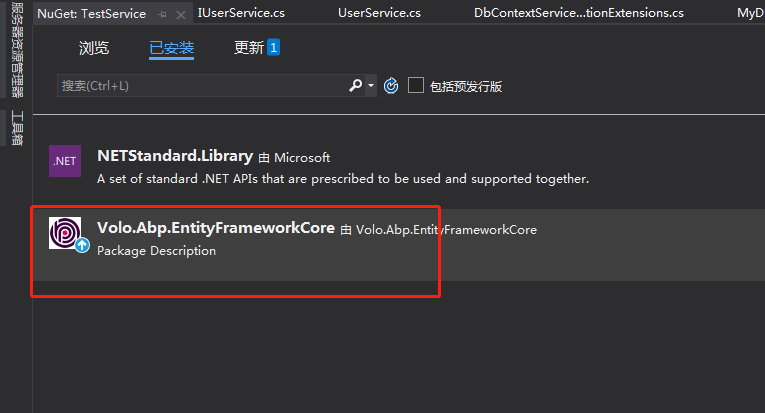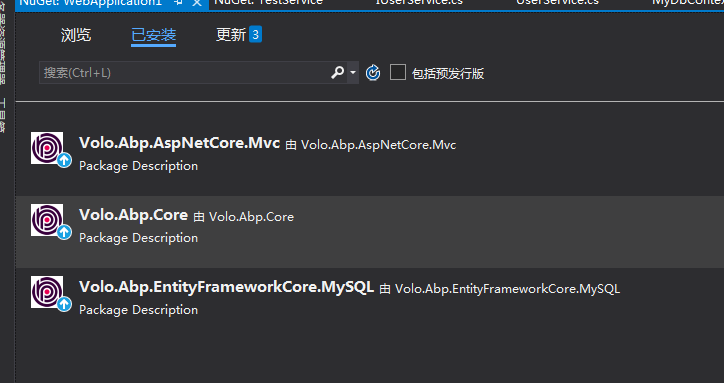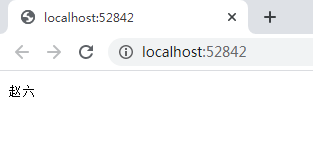ABP-VNEXT 学习笔记(二)数据库连接
在上一章中,我们介绍了如何注入和使用,这都是我们平常用的最多技术点。
这一章呢,我们接着来讲讲,数据库连接。这也是最实用的。 先不管啥DDD的,ABP只是个基础框架,想怎么用都行。
示例环境:
数据库:mysql
ORM:EFCORE
这里的数据库表结构我是手动创建的,没有用dbfirst模式进行迁移。
开始
首先我们新建一个类库,叫TestModel,然后创建一个实体Users
using System.ComponentModel.DataAnnotations.Schema; using Volo.Abp.Domain.Entities; namespace TestModel { [Table("Users")] public class Users: Entity<string> { public string Name { get; set; } } }
类库需要引用下面的包:

这个包里提供聚合根Entity<string>。
在ABP中,一般我们实体都会继承一个聚合根,比如ABP中规范的Entity<string>,这个实体包含一个 固定字段,Id,string为指定的类型,也可以指定为Guid。
数据库中的字段如下图:

简单示例,就2个字段。
然后,按照常规3层 ,我们建一个服务层类库TestService,专门处理业务逻辑的,当然要引用实体层,实现对实体操作。
因为我们是使用EF框架的,所以需要引入ABP的EFcore包。在这里需要明白的是,我们服务层是只引入了EFCORE,而EFCORE本身是支持sqlserver,mysql等多种数据库的。也就是说我们服务层也是支持的。至于具体使用什么数据,在web层去选择。

我们把数据层上下文对象也放到这里来定义,定义一个MyDbContext 上下文对象
using Microsoft.EntityFrameworkCore; using TestModel; using Volo.Abp.EntityFrameworkCore; namespace TestService { //[ConnectionStringName("Default")] //这里可以自定义连接的字符串,对应appsetting.json中ConnectionStrings的子节点,不指定会默认查找Default节点的配置 public class MyDbContext : AbpDbContext<MyDbContext> { public DbSet<Users> users { get; set; } public MyDbContext(DbContextOptions<MyDbContext> options) : base(options) { } } }
然后创建 IUserService 接口
namespace TestService { public interface IUserService { string GetName(string id); } }
再创建一个实现:
using System.Linq; using System.Linq.Dynamic.Core; using TestModel; using Volo.Abp.DependencyInjection; using Volo.Abp.Domain.Repositories; namespace TestService { public class UserService : IUserService, IScopedDependency { private readonly MyDbContext _dbContext; private readonly IRepository<Users, string> _users; public UserService(MyDbContext dbContext, IRepository<Users, string> users) { _dbContext = dbContext; _users = users; } public string GetName(string id) { // return _dbContext.users.FirstOrDefault(m => m.Id == id)?.Name; return _users.FirstOrDefault(m => m.Id == id)?.Name; } } }
在这个实现里面,我们有2种方式获取数据
1:通过注册的数据库上下文来实现
2:通过abp默认的仓储来实现。
当然,以上都需要对应注册了,才能使用。接下来我们还要创建一个继承AbpModule 模块的类。
每个需要注入的类库都需要一个,用于依赖到启动模块,实现该类库的注入。代码如下:
using Volo.Abp.Modularity; namespace TestService { public class TestServiceModule: AbpModule { } }
所有的注入工作,都在AbpModule模块中实现。所以类库需要增加这个继承,再根据每个类自己依赖的IScopedDependency等类型进行注入。
OK,至此,我们服务层的工作已经完成了。
接下来,Web层。
创建一个MVC的应用,引用如下模块包
其中,
Volo.Abp.AspNetCore.Mvc:模块是MVC项目需要
Volo.Abp.Core:是ABP的核心库
Volo.Abp.EntityFrameworkCore.MySQL:这个是我们需要连接的数据库类型。 如果是sqlserver,那就选择安装Volo.Abp.EntityFrameworkCore.SqlServer
同时,还要引入实体层和服务层两个项目。
接下来,跟上一章节类似,我们创建一个AppModule的启动类:
using Microsoft.AspNetCore.Builder; using Microsoft.Extensions.DependencyInjection; using Microsoft.Extensions.Hosting; using TestService; using Volo.Abp; using Volo.Abp.AspNetCore.Mvc; using Volo.Abp.EntityFrameworkCore; using Volo.Abp.Modularity; namespace WebApplication1.Models { [DependsOn( typeof(AbpAspNetCoreMvcModule), //启动MVC模块 typeof(AbpEntityFrameworkCoreModule), //启动EFCODE模块 typeof(TestServiceModule) //启动服务层模块 )] public class AppModule:AbpModule { public override void ConfigureServices(ServiceConfigurationContext context) { context.Services.AddAbpDbContext<MyDbContext>(options => { //注入上下文对象 options.AddDefaultRepositories(includeAllEntities: true);//自动为DbContext中的实体创建默认仓储,默认是为继承了Entity<Guid>的实体创建仓储,如果其他实体也要创建,必须设置includeAllEntities: true }); //配置注入 Configure<AbpDbContextOptions>(options => { options.UseMySQL(); //选择使用mysql数据库 }); } /// <summary> /// 在启动模块初始化中,我们就可以把startup中的配置都搬过来 /// </summary> /// <param name="context"></param> public override void OnApplicationInitialization(ApplicationInitializationContext context) { var app = context.GetApplicationBuilder(); var env = context.GetEnvironment(); if (env.IsDevelopment()) { app.UseDeveloperExceptionPage(); } else { app.UseExceptionHandler("/Home/Error"); } app.UseRouting(); app.UseConfiguredEndpoints(); } } }
这个启动模块类,我们需要依赖3个
1、mvc是必须的,由abp框架提供
2、AbpEntityFrameworkCoreModule是使用EF必须的,由abp框架提供
3、TestServiceModule 这个是实现我们服务层的注入,由我们自己定义。
然后通过下面代码实现上下文注入
context.Services.AddAbpDbContext<MyDbContext>(options => { //注入上下文对象
options.AddDefaultRepositories(includeAllEntities: true);//自动为DbContext中的实体创建默认仓储,默认是为继承了Entity<Guid>的实体创建仓储,如果其他实体也要创建,必须设置includeAllEntities: true
}); //配置注入
然后配置我们的数据库类型:
Configure<AbpDbContextOptions>(options => { options.UseMySQL(); //选择使用mysql数据库 });
如果是其他类型,那需要引用对应的包,这边才能使用对应的数据库。
完成启动类注入后,appsetting.json 进行配置我们的连接字符串,
使用默认配置的话,ConnectionStrings名称不能变。
{ "Logging": { "LogLevel": { "Default": "Information", "Microsoft": "Warning", "Microsoft.Hosting.Lifetime": "Information" } }, "AllowedHosts": "*", "ConnectionStrings": { "Default": "server=192.168.20.134;port=3306;database=eftest;uid=root;pwd=3BIW#lP211HkB4Yq;CharSet=utf8;" //"AbpIdentityServer": "Server=localhost;Database=MyIdsDb;Trusted_Connection=True;", //"AbpPermissionManagement": "Server=localhost;Database=MyPermissionDb;Trusted_Connection=True;" } }
然后,startup中一样实现启动模块
public void ConfigureServices(IServiceCollection services) { services.AddApplication<AppModule>(); } // This method gets called by the runtime. Use this method to configure the HTTP request pipeline. public void Configure(IApplicationBuilder app, IWebHostEnvironment env) { app.InitializeApplication(); }
OK,至此就完成了整个项目的配置。接下来测试,
在home控制中调用服务层输出。
public class HomeController : AbpController //控制器必须继承 AbpController { private readonly IUserService _userService; public HomeController(IUserService userService) { _userService = userService; } public IActionResult Index() { return Content(_userService.GetName("c52c1c0e110146c2b785ab2800fff2f0")); } }
输出结果:

数据库数据:

正确,完成数据库的操作示例。
代码:示例代码地址:https://gitee.com/fei686868/abpvnext-learning-shili
更多分享,请大家关注我的个人公众号:






